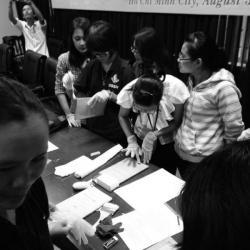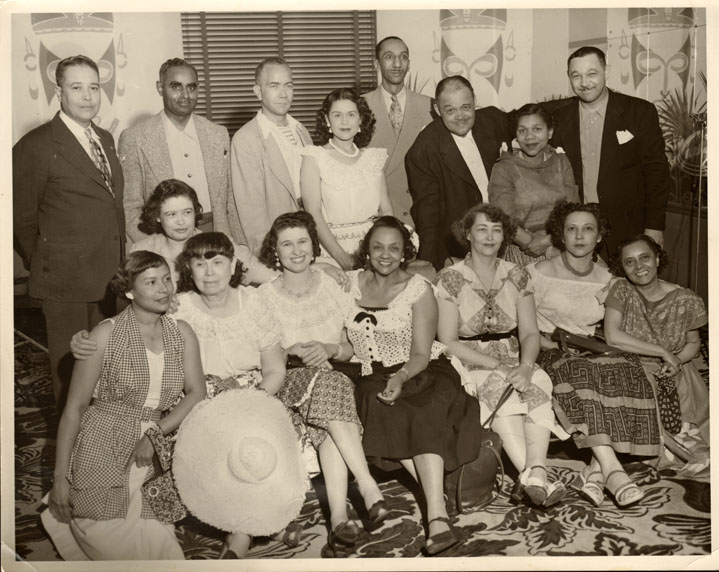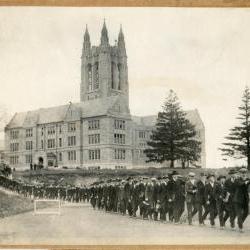- About Archives
- About SAA
- Careers
- Education
- Publications
- Advocacy
- Membership
Although for many of us the Society of American Archivists conference seems to be in the distant past it wasn’t that long ago that approximately 100 college and university archivists joined us for our annual meeting. For those of you who were not able to attend here is a brief synopsis of what was accomplished at that meeting.
Election results: Cynthia Ghering was elected vice chair/chair elect. Caroline Daniels and Benn Joseph were elected to the steering committee.
Tom Sommer provided us with a brief presentation on the Section’s initiative to work with the SAA mentoring program to reach out to college and university archivists who might need mentors to walk them through the tenure and promotion process or publishing. As a complement to this initiative we invited Chris Prom to speak to the section about publishing and getting through the tenure process.
During the second half of the meeting, the section broke into five groups and discussed a series of three “provocative statements.” A member of the steering committee delivered a quick provocative statement and then the groups considered the merits and demerits of the statement. Each group then gave a quick response to the entire room. The statements were as follows:
In other news, the Section Steering Committee completed the revision and approval of the Section’s Best Practices document. We will replace the “Guidelines” document from 1999 with the Best Practices document on our website this fall. In addition to this change, we will also be reviewing our website to update and add content as needed to enhance the user experience for our members. If you would like to make suggestions regarding the type of content you would like to see on the website please contact me.
Christina Zamon, Head of Archives & Special Collections, Emerson College
 Spalenka Conducts Archival Preservation and Digitization Workshop
Spalenka Conducts Archival Preservation and Digitization WorkshopDanielle Spalenka conducted an archival preservation and digitization workshop at the University of Social Sciences & Humanities in Ho Chi Minh City, Vietnam, in August 2014. The workshop was funded through the Endangered Archives Programme Grant awarded to Northern Illinois University Library, where she works as Curator of Manuscripts in the University Archives and Regional History Center. The three-day workshop focused on preserving the manuscripts of the Cham people, an ethnic minority in Vietnam. Topics included basic care and preservation of paper and palm leaf manuscripts, archival principles, and prevention planning and storage. There was also a training session on the basics of digitization to help train a team who will be spending the next year traveling to communities to digitize the manuscripts. The digitized copies will be stored at local institutions in Vietnam and at the British Library, which runs the Endangered Archives Programme.
Submitted by Danielle Spalenka , Curator of Manuscripts, Northern Illinois University.
The University of North Carolina at Greensboro University Archivist Erin Lawrimore has been awarded the UNCG University Libraries’ Innovation and Enrichment Grant for 2014-2015. Her project will focus on enhancing access to oral history recordings conducted by staff of the Martha Blakeney Hodges Special Collections and University Archives (SCUA) as part of the UNCG Institutional Memory Project.
SCUA has a long tradition of conducting and preserving oral history interviews with faculty, administrators, students, and alumni from across the University’s history. These interviews, which typically are an hour or more in length, provide in-depth information about an interviewee’s contributions to and viewpoint on specific time periods or events in campus history. A recent focus has been on documenting the experiences of African American students during the 1960s and 1970s. Often these interviews provide valuable personal insight into history in a way that the official university records cannot.
Currently, access to these oral histories is provided primarily through the interview transcript (the word-for-word text of the interview). Audio recordings are available on CD if requested, but access to these recordings is not provided online. The transcripts are among the highest ranked downloads from across the University Libraries’ digital collections, yet the process of finding relevant information within the transcripts is often challenging due to their lengthy nature.
This project will utilize an open-source tool (the Oral History Metadata Synchronizer, developed by the Louie B. Nunn Center for Oral History at the University of Kentucky Libraries) to provide access to oral history audio recordings online and time-synch the audio recordings to existing transcripts. This will allow researchers to more readily search each oral history recording for relevant information and quickly skip to certain key topics discussed in the interview. At the conclusion of the project in June 2015, it is anticipated that at least 25 enhanced oral history audio recordings and accompanying transcripts will be made available to researchers online. Additionally, the project will establish a workflow for providing enhanced access to additional oral history interviews in SCUA.
Created by UNCG University Libraries Dean Rosann Bazirjian in 2009 and first awarded in 2010, the objective of the Innovation and Program Enrichment Grant is to provide one-time funding of up to $2,500 for projects that will innovatively enhance and expand library services and programs.
Submitted by Erin Lawrimore, University Archivist, University of North Carolina at Greensboro.
 Indiana University South Bend Receives 2014 Indiana Memory Digitization Grant
Indiana University South Bend Receives 2014 Indiana Memory Digitization GrantIndiana University South Bend University Archivist and Associate Librarian, Alison Stankrauff and Joseph Sipocz, Manager of Local & Family History Services at the St. Joseph Public Library partnered to receive a $10,000 Indiana Memory Digitization Grant for their project proposal entitled St. Joseph County African American History Collection.
The grant is being used to digitize photographs, documents and newspapers held by the St. Joseph Public Library, the IU South Bend Civil Rights Heritage Center, and the Franklin D. Schurz Library that tell the story of African Americans in St. Joseph County, Indiana.
The content is being loaded by three student workers hired through grant funding and is available on the Michiana Memory site, a CONTENTdm site. More items are being added through the coming months. By unifying these collections and making them accessible online, researchers, students, and the general public will be able to easily discover and delve into the history and impact of African Americans in the region.
Submitted by Alison Stankrauff, University Archivist and Associate Librarian, Indiana University South Bend.
Earlier this fall, thet Department Special Collections & Archives and Wake Forest University announced the online exhibit 30 Years of Performing Arts: The Secrest Artists Series at Wake Forest Univeristy, 1983–2013. 30 Years of Performing Arts showcases materials related to Wake Forest University’s Secrest Artists Series—which brings established and rising performance artists to the university community—between the years 1983 and 2013. Included in the exhibit are items of visual interest such as event programs, articles from student newspaper the Old Gold & Black, invitations to artist receptions, mailed season schedules, and pocket schedules that illustrate the graphic themes for each season. These represent just a small selection of items from the Secrest Artists Series collection—the working files of Lillian Shelton, whose career with the Secrest Artists Series spanned nearly the entire 30 years. Shelton retired as the director of the series in 2013, and the files are now housed in at the university. A guest post by graduate intern Corrine Luthy provides insights into the process of selecting items for the collection.
Submitted by Rebecca Petersen, Public Services Archivist, Wake Forest University.
 Boston College Focused on University Archives Backlog
Boston College Focused on University Archives BacklogIn honor of Boston College’s sesquicentennial celebrations, the John J. Burns Library is pleased to announce the completion of a yearlong University Archives backlog processing project to make the history of the institution more accessible to researchers. The records of the university’s founder and its first twenty-three presidents were processed or updated, as were the records of the Academic Vice President’s office and several important photograph collections documenting campus history. Over 350 linear feet of University Archives records were processed.
Among the interesting and unexpected finds in the presidents’ papers were faculty loyalty oaths collected during the Cold War; records documenting the Ksar Akil Paleolithic site excavation trips sponsored by the University in the 1930s and 1940s; and centennial celebration records that included John F. Kennedy’s convocation speech on campus in 1963. The selections from the newly processed photograph collections, containing images of Boston College alumni, athletes, buildings, faculty, and special guests, are now being scanned as part of a pilot reference-quality imaging project. Digitized images from the Boston College athletics photographs are online and linked from the finding aid and more collections will follow.
In addition to University Archives, the library’s collection of beautiful Japanese woodblock prints was processed, as were several manuscript collections relating to Boston history. Further resources on Boston College history, are available via a Libguide. Finding aids or catalog records for all newly processed materials are available in the library's catalog.
Submitted by Adrienne Pruitt, Processing Archivist, Boston College.
In May Michigan State University's University Archives and Historical Collections cleared 3000 boxes and 1100 volumes out of a basement storage area to tear down old shelving and install new, high-density storage shelving in its place. The new shelving provides 64% more storage space for theircollections. Summer renovations also included the installation of a new air handler to specifically service collection storage areas. The new air handler allows for better temperature and humidity control. Despite the less-than-ideal research conditions, the repository had one of its busiest summers ever in terms of the number of researchers who visited. This winter a new round of renovations will begin that will expand the reading room, provide additional climate-controlled storage, and create a new work space for students and interns.
In April the institution launched a campaign to help preserve audio-visual collections. Currently the department holds thousands of film reels and videotapes documenting Spartan football, basketball and other sports from the 1930s to the 1990s, as well as agriculture information films, travel films, and musical performances. The film is almost exclusively 16mm, while the video comes in a variety of formats, with the majority being VHS, ¾”, 1”, Betacam and DVCAM. Assistant Director Portia Vescio did an interview with Michigan Public Radio about the importance of the AV collections and intern Matthew Wilcox did an interview with WKAR’s Current State about his work with the multimedia collections. The first six months have raised about $1000 for the care of the film and video collections.
Submitted by Portia Vescio, Assistant Director, Michigan State University, Archives & Historical Collections.
Emerson College Archives and Special Collections (ECASC) has converted three films from 16mm to DVD with support from a $5,300 grant from the National Film Preservation Foundation as part of the College’s commitment to digitally preserve and share its vast collection of historical documents.
The newly preserved films include a short film produced by the College in 1955 to promote the speech and hearing clinic’s service to the Boston community. Shot in black and white, the film shows the Robbins Center two years after opening, and includes footage of the center’s founding faculty members working with children who have speech and hearing disorders. Another black and white film about the center, titled Strong Hand, Helping Hand, was produced in 1960. It includes the only existing shot of the College’s Back Bay campus during this time period. The narration gives a detailed description of the program in its early days. A film from 1966 about the Thayer Lindsley Nursery, produced one year after it opened, includes footage of families who came to the nursery for treatment. Filmed in color, it highlights technologies and techniques used during the 1960s to treat children with speech and hearing problems and features candid discussions with mothers who share their experiences of caring for their children.
The films will be available to all researchers in the Emerson College Archives and Special Collections.
Submitted by Christina Zamon, Head of Archives & Special Collections, Emerson College.